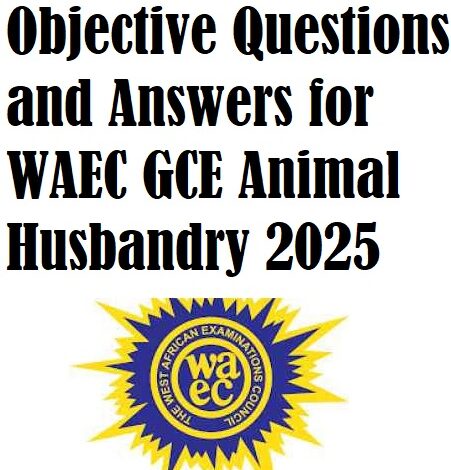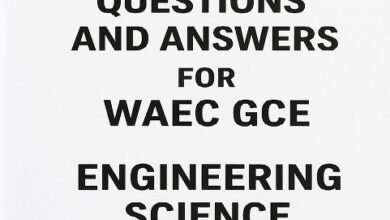Objective Questions and Answers for WAEC GCE Animal Husbandry 2025

Objective Questions and Answers for WAEC GCE Animal Husbandry 2025
Section A: Introduction to Animal Husbandry
-
Animal husbandry is the branch of agriculture concerned with
A. soil fertility improvement
B. rearing and management of livestock
C. crop production
D. forest preservation
Answer: B -
The main purpose of animal husbandry is to
A. reduce deforestation
B. increase crop yield
C. produce food and raw materials of animal origin
D. conserve wildlife
Answer: C -
The scientific study of animal behaviour is called
A. ecology
B. ethology
C. anatomy
D. physiology
Answer: B -
One advantage of mixed farming is that
A. animals compete with crops for nutrients
B. animal wastes can fertilize the soil
C. weeds increase rapidly
D. it increases cost of labour
Answer: B -
A farm that keeps only cattle for milk production is known as a
A. beef farm
B. dairy farm
C. ranch
D. feedlot
Answer: B -
Extensive system of animal rearing is mostly practiced where
A. land is scarce
B. population is high
C. land is abundant
D. urbanization is intense
Answer: C -
The process of keeping animals in a confined area where they are fed intensively is
A. ranching
B. nomadism
C. zero grazing
D. transhumance
Answer: C -
The primary aim of animal breeding is to
A. produce hybrid seeds
B. improve genetic quality of livestock
C. increase forest animals
D. prevent diseases
Answer: B -
An example of a monogastric animal is
A. cow
B. goat
C. pig
D. sheep
Answer: C -
Animals that chew the cud are called
A. omnivores
B. ruminants
C. carnivores
D. monogastrics
Answer: B
Objective Questions and Answers for WAEC GCE Animal Husbandry 2025
Section B: Livestock Nutrition
-
The main nutrient required for body building is
A. carbohydrate
B. protein
C. fat
D. vitamins
Answer: B -
Which of the following is a concentrate feed?
A. Hay
B. Maize grain
C. Pasture
D. Silage
Answer: B -
Roughages are important in the diet of ruminants because they
A. supply minerals only
B. add bulk and aid digestion
C. increase disease resistance
D. increase appetite
Answer: B -
The deficiency of calcium in young animals causes
A. anemia
B. rickets
C. goitre
D. blindness
Answer: B -
Urea can be used in livestock feeding as a
A. carbohydrate source
B. protein supplement (non-protein nitrogen)
C. fat source
D. vitamin source
Answer: B -
The feed given to newly hatched chicks is called
A. growers mash
B. finishers mash
C. chick mash
D. layer mash
Answer: C -
Which feed ingredient provides energy in animal rations?
A. Bone meal
B. Maize
C. Fish meal
D. Oyster shell
Answer: B -
The green feed preserved by fermentation is known as
A. hay
B. silage
C. fodder
D. concentrate
Answer: B -
The vitamin that prevents night blindness is
A. vitamin A
B. vitamin B
C. vitamin C
D. vitamin D
Answer: A -
The part of the ruminant stomach that acts as a fermentation vat is
A. abomasum
B. omasum
C. rumen
D. reticulum
Answer: C
Section C: Animal Breeding and Reproduction
-
The act of giving birth in farm animals is called
A. lactation
B. parturition
C. ovulation
D. conception
Answer: B -
The period between fertilization and birth is
A. gestation period
B. incubation period
C. lactation period
D. breeding period
Answer: A -
The male parent used in breeding is called
A. dam
B. sire
C. litter
D. calf
Answer: B -
The process of introducing semen into the reproductive tract of a female by artificial means is
A. inbreeding
B. artificial insemination
C. line breeding
D. natural mating
Answer: B -
Crossbreeding is the mating of
A. animals of the same breed
B. animals of different breeds
C. male and female of same species
D. animals of different species
Answer: B -
Inbreeding leads to
A. hybrid vigor
B. increased genetic variation
C. reduced performance due to close relation
D. resistance to disease
Answer: C -
Castration is carried out in male animals to
A. increase aggressiveness
B. reduce libido and improve meat quality
C. improve fertility
D. increase horn size
Answer: B -
The reproductive organ that produces eggs in female animals is the
A. uterus
B. ovary
C. oviduct
D. vulva
Answer: B -
The term “heat period” refers to
A. gestation
B. lactation
C. oestrus
D. weaning
Answer: C -
The main advantage of artificial insemination is that it
A. reduces milk yield
B. increases disease spread
C. allows wider use of superior sires
D. increases feed consumption
Answer: C
Objective Questions and Answers for WAEC GCE Animal Husbandry 2025
Section D: Livestock Management
-
Brooding is the process of
A. raising chicks under controlled warmth
B. feeding adult birds
C. controlling diseases in pigs
D. grooming of goats
Answer: A -
The recommended brooding temperature for day-old chicks is about
A. 18°C
B. 25°C
C. 32°C
D. 42°C
Answer: C -
The act of removing the beak tip of chicks is called
A. debeaking
B. dehorning
C. docking
D. drenching
Answer: A -
The function of the crop in poultry is to
A. grind food
B. store food temporarily
C. digest protein
D. absorb nutrients
Answer: B -
The main product of dairy cattle is
A. meat
B. milk
C. hide
D. horn
Answer: B -
Milking is usually done
A. once a day
B. twice daily
C. weekly
D. irregularly
Answer: B -
The weaning of piglets is done at about
A. 2–3 weeks
B. 6–8 weeks
C. 10–12 weeks
D. 16 weeks
Answer: B -
A castrated male sheep is known as a
A. boar
B. steer
C. wether
D. bullock
Answer: C -
The process of removing the horns of animals is called
A. dehorning
B. castration
C. docking
D. drenching
Answer: A -
A good housing system for pigs should
A. have poor drainage
B. be well ventilated and drained
C. be dark and wet
D. be built on lowland
Answer: B
Section E: Livestock Diseases and Parasites
-
The causative agent of anthrax is a
A. bacterium
B. virus
C. protozoan
D. fungus
Answer: A -
Newcastle disease affects mainly
A. cattle
B. pigs
C. poultry
D. sheep
Answer: C -
Foot and mouth disease is caused by a
A. virus
B. fungus
C. bacterium
D. worm
Answer: A -
The vector of trypanosomiasis is
A. mosquito
B. tsetse fly
C. housefly
D. tick
Answer: B -
Internal parasites of livestock include
A. lice and ticks
B. roundworms and tapeworms
C. fleas and mites
D. flies and lice
Answer: B -
Which of these is a symptom of mastitis?
A. Swollen udder and clotted milk
B. Loss of appetite
C. Rough coat
D. Scouring
Answer: A -
Ectoparasites live
A. inside the host body
B. outside on the skin or surface
C. in the digestive tract
D. in the lungs
Answer: B -
The most effective way of preventing livestock diseases is
A. curative medicine
B. vaccination and hygiene
C. isolation only
D. daily watering
Answer: B -
The drug used to kill internal parasites is called
A. disinfectant
B. pesticide
C. antiseptic
D. anthelmintic
Answer: D -
Rinderpest is a disease of
A. poultry
B. cattle
C. pigs
D. rabbits
Answer: B
Objective Questions and Answers for WAEC GCE Animal Husbandry 2025
Section F: Pasture and Forage Management
-
The natural vegetation grazed by livestock is called
A. fodder
B. silage
C. pasture
D. hay
Answer: C -
The practice of grazing animals in sequence on different paddocks is
A. continuous grazing
B. strip grazing
C. rotational grazing
D. free range
Answer: C -
Leguminous forages are important because they
A. add nitrogen to the soil
B. reduce protein in feed
C. cause erosion
D. provide only roughage
Answer: A -
A good pasture should contain
A. only grasses
B. only legumes
C. a mixture of grasses and legumes
D. shrubs and weeds
Answer: C -
The process of conserving green fodder in an airtight pit is
A. hay making
B. silage making
C. fermentation
D. composting
Answer: B -
One example of a leguminous forage is
A. guinea grass
B. elephant grass
C. centrosema
D. carpet grass
Answer: C -
The best time to cut pasture for hay is when it is
A. overripe
B. in early flowering stage
C. at seed maturity
D. dry and brown
Answer: B -
The main advantage of silage over hay is that it
A. can be stored for a short time
B. is more palatable and retains nutrients
C. is cheaper to make
D. requires no equipment
Answer: B -
Which of the following grasses is suitable for grazing cattle?
A. Spear grass
B. Guinea grass
C. Water hyacinth
D. Couch weed
Answer: B -
Overgrazing of pasture leads to
A. increased fertility
B. soil erosion and weed invasion
C. higher yield
D. dense vegetation
Answer: B
ANIMAL HUSBANDRY (ALTERNATIVE A) 3 – ALTERNATIVE TO PRACTICAL WORK (WAEC 2025 Practice Edition)
This paper tests candidates’ practical knowledge and application of animal husbandry concepts observation, identification, measurement, and interpretation as expected in WAEC Paper 3.
INSTRUCTION TO CANDIDATES
-
Answer all questions.
-
Write your answers in the spaces provided on your answer booklet.
-
You are advised to study the diagrams and specimens carefully before answering.
SECTION A: IDENTIFICATION OF SPECIMENS
Question 1
Study specimens A, B, and C carefully and answer the questions that follow.
-
Specimen A – Ground maize grain
-
Specimen B – Fish meal
-
Specimen C – Bone meal
(a) Identify specimens A, B, and C.
(b) State one source of each specimen.
(c) For each specimen, state the major nutrient supplied.
(d) Mention one function of each nutrient in animal nutrition.
Suggested Answers
| Specimen | Identification | Source | Major Nutrient | Function |
|---|---|---|---|---|
| A | Ground maize grain | Maize plant | Carbohydrate | Provides energy |
| B | Fish meal | Fish waste | Protein | Growth and tissue repair |
| C | Bone meal | Animal bones | Mineral (Calcium/Phosphorus) | Bone and teeth formation |
Question 2
Study specimens D and E carefully.
-
Specimen D – Cowpea hay
-
Specimen E – Silage
(a) State the method of preservation used for each specimen.
(b) Mention one advantage and one disadvantage of each method.
(c) State one condition necessary for successful preservation of each specimen.
(d) Mention two differences between hay and silage.
Suggested Answers
| Preservation Type | Advantage | Disadvantage | Condition | Difference |
|---|---|---|---|---|
| Hay (sun-dried) | Cheap and simple | Nutrient loss if over-dried | Good sunshine and ventilation | Dry, rough, lighter |
| Silage (fermentation) | Retains nutrients and is palatable | Requires airtight condition | Anaerobic (air-free) condition | Moist, fermented, greenish |
Objective Questions and Answers for WAEC GCE Animal Husbandry 2025
Question 3
Study specimens F and G carefully.
-
Specimen F – Tsetse fly
-
Specimen G – Tick
(a) Identify specimens F and G.
(b) State two effects of each on livestock.
(c) Mention one disease transmitted by each.
(d) Suggest two control measures for each parasite.
Suggested Answers
| Specimen | Identification | Effects | Disease Transmitted | Control Measures |
|---|---|---|---|---|
| F | Tsetse fly | Anemia, weight loss | Trypanosomiasis | Clearing bush, insecticide spraying |
| G | Tick | Blood loss, skin irritation | Redwater disease | Dipping, spraying acaricides |
SECTION B: ANATOMY AND PHYSIOLOGY
Question 4
Study the diagram of the digestive system of a ruminant provided and answer the questions that follow.
(a) Label the following parts:
(i) Rumen
(ii) Reticulum
(iii) Omasum
(iv) Abomasum
(b) State one function of each part labeled.
(c) Explain briefly how the ruminant is adapted to feed on roughages.
Suggested Answers
-
Rumen – Fermentation chamber where microbes digest cellulose.
-
Reticulum – Traps foreign materials and forms cud.
-
Omasum – Absorbs water and reduces feed particles.
-
Abomasum – True stomach; secretes digestive enzymes.
Adaptation:
Ruminants have microorganisms in their rumen that digest fibrous feed and allow regurgitation (cud-chewing) to ensure complete digestion of cellulose.
Question 5
Study the diagram of the reproductive system of a female mammal and answer the following questions.
(a) Label the following parts:
(i) Ovary
(ii) Oviduct
(iii) Uterus
(iv) Vagina
(b) State one function of each labeled part.
(c) Mention two signs of oestrus in a female cow.
Suggested Answers
-
Ovary: Produces ova (eggs) and hormones (oestrogen, progesterone).
-
Oviduct: Site of fertilization; transports eggs to uterus.
-
Uterus: Site of implantation and embryo development.
-
Vagina: Passage for mating and birth.
Signs of Oestrus:
Restlessness, mounting other animals, mucus discharge, swollen vulva.
SECTION C: MANAGEMENT PRACTICES
Question 6
Specimens H and I are parts of livestock housing equipment.
-
Specimen H – Feed trough
-
Specimen I – Water trough
(a) Identify specimens H and I.
(b) State one material used in constructing each.
(c) Mention two maintenance practices for each.
(d) Explain one importance of each in animal management.
Suggested Answers
| Specimen | Material | Maintenance | Importance |
|---|---|---|---|
| Feed Trough | Concrete/wood | Clean regularly, repair cracks | Reduces feed wastage |
| Water Trough | Galvanized metal/plastic | Wash daily, disinfect | Provides clean drinking water |
Question 7
Study the following specimens:
-
Specimen J – Syringe
-
Specimen K – Thermometer
(a) Identify specimens J and K.
(b) State one use of each.
(c) Mention two precautions to observe when using specimen J.
(d) State the normal body temperature of cattle.
Suggested Answers
| Specimen | Identification | Use | Precautions | Normal Temperature |
|---|---|---|---|---|
| J | Syringe | Inject drugs or vaccines | Sterilize before use; avoid air bubbles | 38.5°C – 39.5°C |
| K | Thermometer | Measure body temperature | Clean before/after use | — |
SECTION D: RECORDS AND FARM MANAGEMENT
Objective Questions and Answers for WAEC GCE Animal Husbandry 2025
Question 8
You are provided with the following record extract of a poultry flock:
| Date | Number of Birds | Feed (kg) | Eggs Collected |
|---|---|---|---|
| 1st June | 100 | 20 | 70 |
| 2nd June | 100 | 20 | 75 |
| 3rd June | 100 | 20 | 80 |
(a) Calculate the average feed consumption per bird per day.
(b) Calculate the average egg production per bird per day.
(c) State two uses of farm records.
Answers
(a) Average feed per bird per day = 20 kg ÷ 100 = 0.2 kg
(b) Average egg production = (70 + 75 + 80) ÷ 3 ÷ 100 = 0.75 eggs/bird/day
(c) Uses: To monitor productivity, detect losses, and plan future management.
Question 9
Specimen L shows a simple diagram of a pig pen.
(a) State four features of a good pig pen.
(b) Mention two importance of good housing in livestock production.
(c) List two materials suitable for building a pig pen.
Suggested Answers
-
Features: Concrete floor, proper drainage, adequate ventilation, strong walls, feeding area.
-
Importance: Disease prevention, comfort and growth, easy cleaning.
-
Materials: Cement, blocks, galvanized roofing sheets.
Question 10
Study specimen M (a dairy cow udder).
(a) State two signs that indicate the cow is ready for milking.
(b) Mention three precautions during milking.
(c) State two causes of mastitis in dairy cows.
Suggested Answers
-
Signs: Full udder, restlessness, presence of milk on teat tip.
-
Precautions: Wash udder, avoid injury, use clean containers.
-
Causes: Dirty environment, bacterial infection, improper milking.
SUMMARY OF SPECIMENS USED
| Code | Specimen | Type |
|---|---|---|
| A | Ground maize | Feedstuff |
| B | Fish meal | Feedstuff |
| C | Bone meal | Feedstuff |
| D | Hay | Forage |
| E | Silage | Forage |
| F | Tsetse fly | Parasite |
| G | Tick | Parasite |
| H | Feed trough | Equipment |
| I | Water trough | Equipment |
| J | Syringe | Tool |
| K | Thermometer | Tool |
| L | Pig pen diagram | Housing |
| M | Cow udder | Livestock part |
TOTAL: 10 PRACTICAL QUESTIONS (FULL WAEC FORMAT)
Covers:
-
Feed and nutrition
-
Forage preservation
-
Parasites and diseases
-
Anatomy
-
Reproduction
-
Housing and management
-
Farm tools and records



